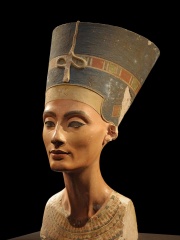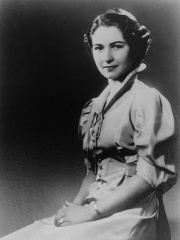







The Most Famous
COMPANIONS from Egypt
This page contains a list of the greatest Egyptian Companions. The pantheon dataset contains 784 Companions, 18 of which were born in Egypt. This makes Egypt the birth place of the 11th most number of Companions behind United States, and Denmark.
Top 10
The following people are considered by Pantheon to be the top 10 most legendary Egyptian Companions of all time. This list of famous Egyptian Companions is sorted by HPI (Historical Popularity Index), a metric that aggregates information on a biography's online popularity. Visit the rankings page to view the entire list of Egyptian Companions.

1. Nefertiti (1400 BC - 1330 BC)
With an HPI of 87.28, Nefertiti is the most famous Egyptian Companion. Her biography has been translated into 99 different languages on wikipedia.
Nefertiti () (c. 1370 – c. 1330 BC) was a queen of the 18th Dynasty of Ancient Egypt, the great royal wife of Pharaoh Akhenaten. Nefertiti and her husband were known for their radical overhaul of state religious policy, in which they promoted an exclusivist and possibly even monotheistic religion, Atenism, centered on the sun disc and its direct connection to the royal household. With her husband, she reigned at what was arguably the wealthiest period of ancient Egyptian history. After her husband's death, some scholars believe that Nefertiti ruled briefly as the female pharaoh known by the throne name Neferneferuaten just before the ascension of Tutankhamun, although this identification is a matter of ongoing debate. If Nefertiti did rule as pharaoh, her reign was marked by the fall of Amarna and the relocation of the capital back to the traditional city of Memphis after her death. In the 20th century, Nefertiti was made famous by the discovery and display of her ancient bust, now in Berlin's Neues Museum. The bust is one of the most copied works of the art of ancient Egypt. It is attributed to the Egyptian sculptor Thutmose, and was excavated from his buried studio complex in the early 20th century.

2. Nefertari (1290 BC - 1255 BC)
With an HPI of 79.56, Nefertari is the 2nd most famous Egyptian Companion. Her biography has been translated into 52 different languages.
Nefertari (also known as Nefertari Meritmut; Akkadian: Naptera) was an Egyptian queen and the first of the Great Royal Wives (or principal wives) of Ramesses the Great. She is one of the best known Egyptian queens, among such women as Cleopatra, Nefertiti, and Hatshepsut, and one of the most prominent not known or thought to have reigned in her own right. She was highly educated and able to both read and write hieroglyphs, a very rare skill at the time. She used these skills in her diplomatic work, corresponding with other prominent royals of the time. Her lavishly decorated tomb, QV66, is one of the largest and most spectacular in the Valley of the Queens. Ramesses also constructed a temple for her at Abu Simbel next to his colossal monument there.

3. Ankhesenamun (1347 BC - 1400 BC)
With an HPI of 77.52, Ankhesenamun is the 3rd most famous Egyptian Companion. Her biography has been translated into 46 different languages.
Ankhesenamun (ˁnḫ-s-n-imn, "Her Life Is of Amun"; c. 1348 or c. 1342 – after 1322 BC) was an ancient Egyptian queen who lived during the 18th Dynasty of Egypt. Born Ankhesenpaaten (ˁnḫ.s-n-pꜣ-itn, "she lives for the Aten"), she was the third of six known daughters of the Egyptian Pharaoh Akhenaten and his Great Royal Wife Nefertiti. She became the Great Royal Wife of Tutankhamun. The change in her name reflects the changes in ancient Egyptian religion during her lifetime after her father's death. Her youth is well documented in the ancient reliefs and paintings of the reign of her parents. Ankhesenamun was not very well documented as being the Great Royal Wife of Pharaoh Tutankhamun. Initially, she may have been married to her father and it is possible that, upon the death of Tutankhamun, she was married briefly to Tutankhamun's successor, Ay, who is believed by some to be her maternal grandfather. DNA test results on mummies discovered in KV21 were released in February 2010, which has given rise to speculation that one of two late 18th Dynasty queens buried in that tomb could be Ankhesenamun. Because of their DNA, both mummies are thought to be members of that ruling house.

4. Fawzia Fuad of Egypt (1921 - 2013)
With an HPI of 72.31, Fawzia Fuad of Egypt is the 4th most famous Egyptian Companion. Her biography has been translated into 47 different languages.
Fawzia of Egypt (Arabic: فوزية; 5 November 1921 – 2 July 2013), also known as Fawzia Pahlavi or Fawzia Chirine, was an Egyptian princess who became Queen of Iran as the first wife of Mohammad Reza Pahlavi, Shah of Iran. Fawzia was the daughter of Fuad I, seventh son of Ismail the Magnificent. Her marriage to the Iranian Crown Prince in 1939 was a political deal: it consolidated Egyptian power and influence in the Middle East, while bringing respectability to the Egyptian regime by association with the much more prestigious Iranian royal house. Fawzia obtained an Egyptian divorce in 1948, under which their one daughter Princess Shahnaz would be brought up in Iran. Fawzia, who was known as the "sad queen" in the press, lived in isolation and silence after the 1952 Egyptian revolution and never published her memories of the court of Iran and Egypt. In 1949, Fawzia married Colonel Ismail Chirine, an Egyptian diplomat, with whom she had a son and a daughter.

5. Arsinoe II (316 BC - 270 BC)
With an HPI of 70.16, Arsinoe II is the 5th most famous Egyptian Companion. Her biography has been translated into 42 different languages.
Arsinoë II (Koine Greek: Ἀρσινόη, c. 316 BC – between 270 and 268 BC) was Queen consort of Thrace, Anatolia, and Macedonia by her first and second marriage, to king Lysimachus and king Ptolemy Keraunos respectively, and then Queen of the Ptolemaic Kingdom of Egypt by marriage to her brother, Pharaoh Ptolemy II Philadelphus. As an Egyptian queen she acquired the royal name Arsinoe Philadelphos, as well the title nswt-bjtj ("King of Upper and Lower Egypt") that may suggest she was co-ruler with her husband; the exact meaning of this elevation and whether it occurred during her life or posthumously is uncertain. After her death, Arsinoe was deified at the orders of her husband and the cult of Arsinoe Philadelphos became widespread in the Ptolemaic territories.

6. Tjuyu (1401 BC - 1370 BC)
With an HPI of 70.15, Tjuyu is the 6th most famous Egyptian Companion. Her biography has been translated into 25 different languages.
Thuya (sometimes transliterated as Touiyou, Thuiu, Tuya, Tjuyu or Thuyu) was an Egyptian noblewoman and the mother of queen Tiye, and the wife of Yuya. She is the grandmother of Akhenaten, and great grandmother of Tutankhamun.

7. Meritamen (1400 BC - 1300 BC)
With an HPI of 69.06, Meritamen is the 7th most famous Egyptian Companion. Her biography has been translated into 22 different languages.
Meritamen (also spelled Meritamon, Meritamun, Merytamen, Merytamun, Meryt-Amen; ancient Egyptian: Beloved of Amun) was a daughter and later Great Royal Wife of Pharaoh Ramesses the Great, born by his first queen Nefertari.

8. Nazli Sabri (1894 - 1978)
With an HPI of 68.27, Nazli Sabri is the 8th most famous Egyptian Companion. Her biography has been translated into 28 different languages.
Nazli Sabri (Arabic: نازلي صبري; 25 June 1894 – 29 May 1978) was the first queen consort in the Kingdom of Egypt from 1919 to 1936. She was the second wife of King Fuad I.

9. Meketaten (1348 BC - 1338 BC)
With an HPI of 67.38, Meketaten is the 9th most famous Egyptian Companion. Her biography has been translated into 27 different languages.
Meketaten (Ancient Egyptian: mꜥkt itn, meaning "Behold the Aten" or "Protected by Aten") was the second of six daughters born to the Egyptian Pharaoh Akhenaten and his Great Royal Wife Nefertiti. She likely lived between Year 4 and Year 14 of Akhenaten's reign. Although little is known about her, she is frequently depicted with her sisters accompanying her royal parents in the first two-thirds of the Amarna Period.

10. Farida of Egypt (1921 - 1988)
With an HPI of 66.98, Farida of Egypt is the 10th most famous Egyptian Companion. Her biography has been translated into 24 different languages.
Farida (born Safinaz Zulficar Arabic: صافيناز ذو الفقار 5 September 1921 – 16 October 1988) was the queen of Egypt for nearly eleven years as the first wife of King Farouk. She was the first queen of Egypt since Cleopatra to have left seclusion and played a public representational role, attending public functions and acting as honorary protector of charities, in accordance with the modern image the monarchy wished to represent at the time. The marriage was dissolved by divorce in 1948.
People
Pantheon has 18 people classified as Egyptian companions born between 1950 BC and 1948. Of these 18, 2 (11.11%) of them are still alive today. The most famous living Egyptian companions include Suzanne Mubarak, and Antigone Costanda. The most famous deceased Egyptian companions include Nefertiti, Nefertari, and Ankhesenamun.
Living Egyptian Companions
Go to all RankingsDeceased Egyptian Companions
Go to all RankingsNefertiti
1400 BC - 1330 BC
HPI: 87.28
Nefertari
1290 BC - 1255 BC
HPI: 79.56
Ankhesenamun
1347 BC - 1400 BC
HPI: 77.52
Fawzia Fuad of Egypt
1921 - 2013
HPI: 72.31
Arsinoe II
316 BC - 270 BC
HPI: 70.16
Tjuyu
1401 BC - 1370 BC
HPI: 70.15
Meritamen
1400 BC - 1300 BC
HPI: 69.06
Nazli Sabri
1894 - 1978
HPI: 68.27
Meketaten
1348 BC - 1338 BC
HPI: 67.38
Farida of Egypt
1921 - 1988
HPI: 66.98
Alia Al-Hussein
1948 - 1977
HPI: 66.71
Bintanath
1300 BC - 1300 BC
HPI: 65.76
Overlapping Lives
Which Companions were alive at the same time? This visualization shows the lifespans of the 6 most globally memorable Companions since 1700.





